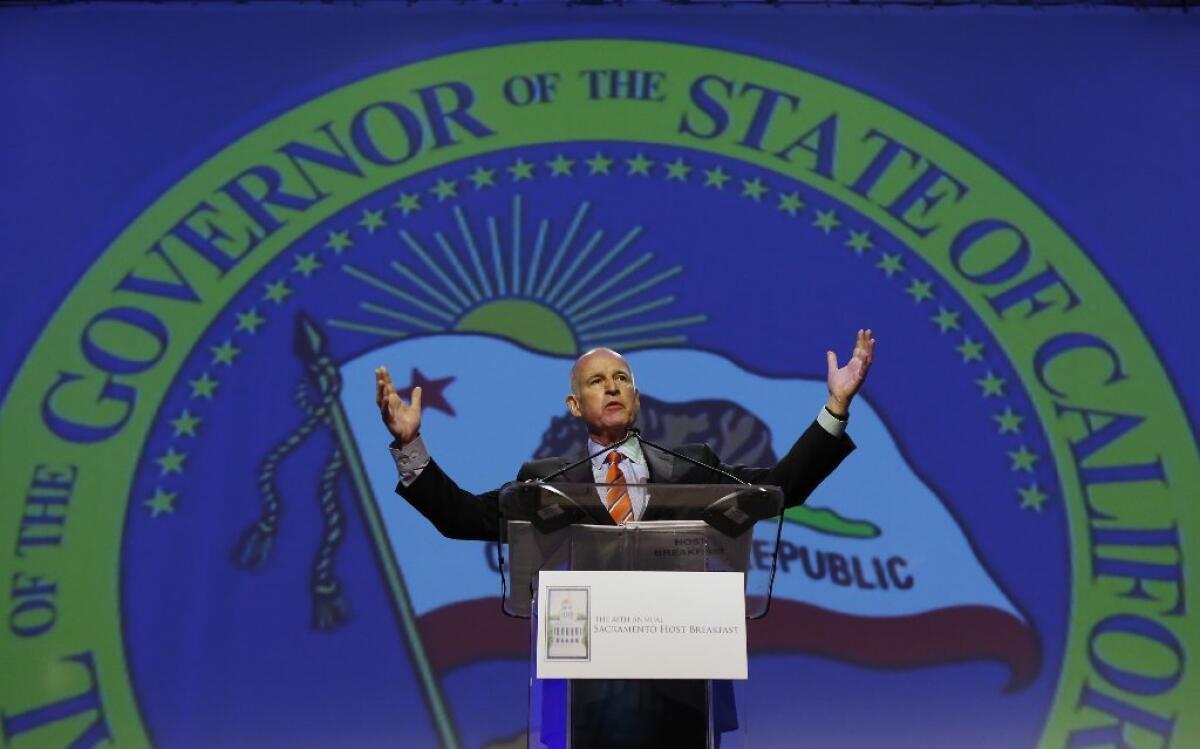Who comes after Jerry Brown as California’s next governor: The three top picks

- Share via
Even as Californians prepare to elect — or, more likely, reelect — a governor in November, some of the state’s top political minds are turning to the question of what comes after Gov. Jerry Brown. In one sense, it’s a difficult question: Brown’s family has commanded so much influence for so long in California that it’s hard to imagine the state without a Brown at the center of its politics. Still, even dynasties fade, and this one will too.
Who comes next? Almost all of those I spoke to — politicians, consultants, elected officials, labor and business leaders — ticked off one of three names: Lt. Gov. Gavin Newsom, Atty. Gen. Kamala Harris and former Los Angeles Mayor Antonio Villaraigosa. Each has formidable strengths and significant challenges. All three stand a very good chance of succeeding Brown as governor.
It’s still a long way off, and much can change between now and the 2018 election. For starters, Brown, Harris and Newsom all have opponents this fall, and any of them could, in theory, lose. Anything’s possible in politics, but no one I consulted gives any of their opponents a serious chance. Should they all win and return for second terms, there’s always the chance that Brown would prove unable to complete his. In that event, Newsom would become governor and would be running for reelection in four years.
In the more likely event that Brown wins and serves out a fourth and final term, Newsom and Harris would be the most obvious contenders to follow him. They both came up through the rough politics of San Francisco, where elections are won house to house, and they are seasoned, attractive, intelligent and polished. Newsom will always hold a special place in the history of California — and in the hearts of many gay constituents — for having kick-started gay marriage as mayor of San Francisco. Harris was an innovative and tough San Francisco district attorney, and she would draw national attention if she were poised to become the first woman, the first African American and the first South Asian to serve as California’s governor.
Over the next four years, moreover, Harris has a distinct advantage over Newsom: She has a real job. Newsom has made the most of the lieutenant governorship, gamely advancing job growth and technology, among other issues, but his position doesn’t give him much to do. Harris, by contrast, has used her office to defend homeowners facing foreclosure, to argue for privacy protections for consumers, to fight human trafficking and even to combat truancy. She can build a record of achievement over the next four years; Newsom may find it harder.
And then there’s Villaraigosa. The former mayor slipped almost instantly out of sight when he completed his second term last year. And it’s safe to say he hasn’t been universally missed by a city sometimes weary of his peculiar mix of warmth, energy and self-aggrandizement. And yet, his record shows signs of wearing well with time: The money he helped secure for transportation improvements is helping build a subway to the sea and — almost — to the airport. The economy is steadily improving, Downtown’s transformation has resumed its pre-recession energy; crime remains at historically low levels. Four years from now, Villaraigosa may be able to point with pride toward his record as mayor and use it to launch his return to politics.
Tactically, Villaraigosa also could benefit from the demographics of this contest: If Harris and Newsom split Northern California Democrats and their various bases, he could run as the lone Southern Californian and the lone Latino, uniting that region and that group behind him.
His main troubles are in the area of money and enemies. As he wound down his time as mayor, Villaraigosa, a former union organizer, seemed to delight in thrashing teachers unions. They won’t forget, and there are few enemies more serious for a Democratic candidate for statewide office than the California Teachers Assn. That underscores his second challenge: It takes big money to run in California — especially if teachers are prepared to spend against a candidate — and it’s hard to raise that cash when out of office.
Finally, there is one other twist to consider: Californians may not witness the retirement of just one historic political figure in four years. Sen. Dianne Feinstein, already 81, may bring her long and storied career to an end as well. If so, that would leave two openings, not just one — and would thus double the opportunities for California’s leading politicians to step up.
Twitter: @newton_jim
More to Read
A cure for the common opinion
Get thought-provoking perspectives with our weekly newsletter.
You may occasionally receive promotional content from the Los Angeles Times.







